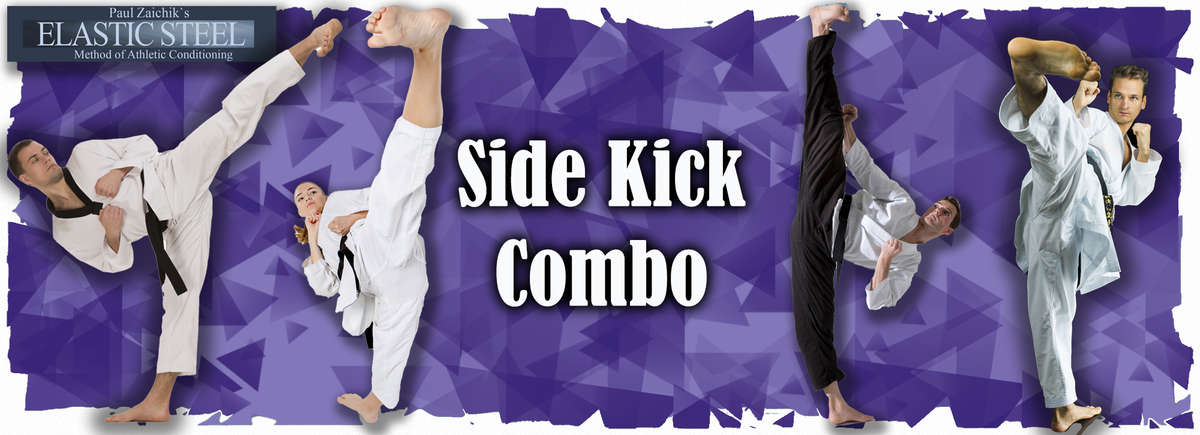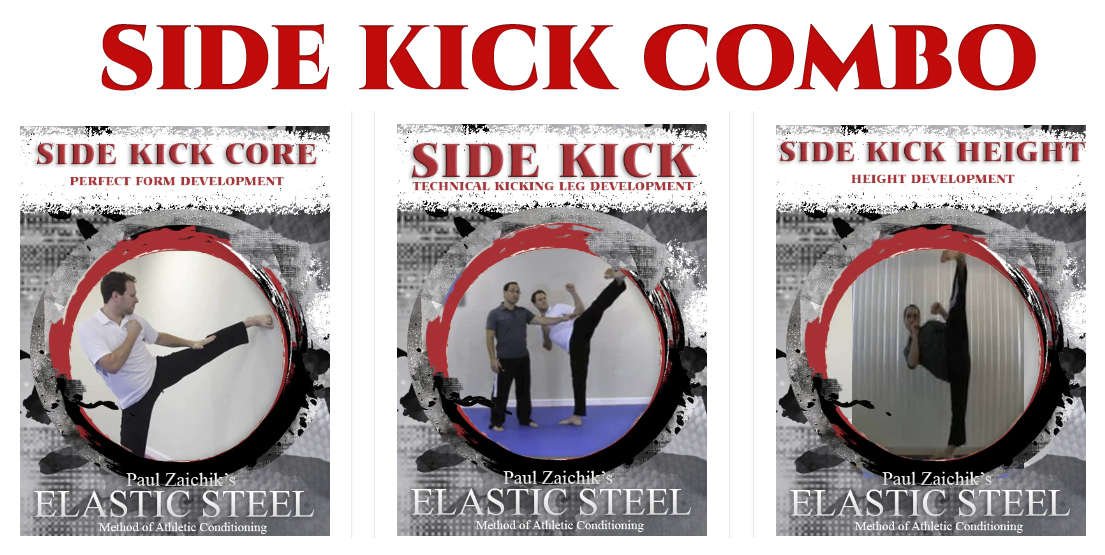
This combo is your gateway to mastering a flawlessly controlled side kick that soars above head level, allowing you to sustain it effortlessly, just as easily as you would hold up your arm.
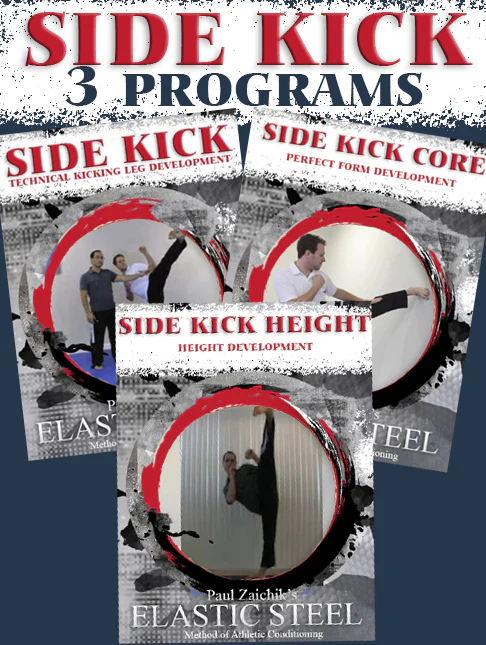
Get this kick combo today!
- Visible results in just a few workouts
- Unique stretching and strengthening techniques to improve the power of your sidekick
- Rapid progress.
- Lasting results.
- No pain.
- No injuries.
- Flexibility and strength combined.
- 2 - 3 times per week.
- Train at home. At your pace. From any device.
- Instant access.
- No hidden fees. No surprises.
- Regular price is $89.95. Limited time price: $49.95
These programs were designed by Paul Zaichik, martial arts and kinesiology expert, founder of ElasticSteel Method of Athletic Conditining, EasyFlexibility and Zaichik Stretching Techniques, in 2005. Paul Zaichik and his team have been perfecting martial arts training since then, and here we bring you all this distilled knowledge to make you and unstoppable kicking machine.
Here is what is included in this combo...
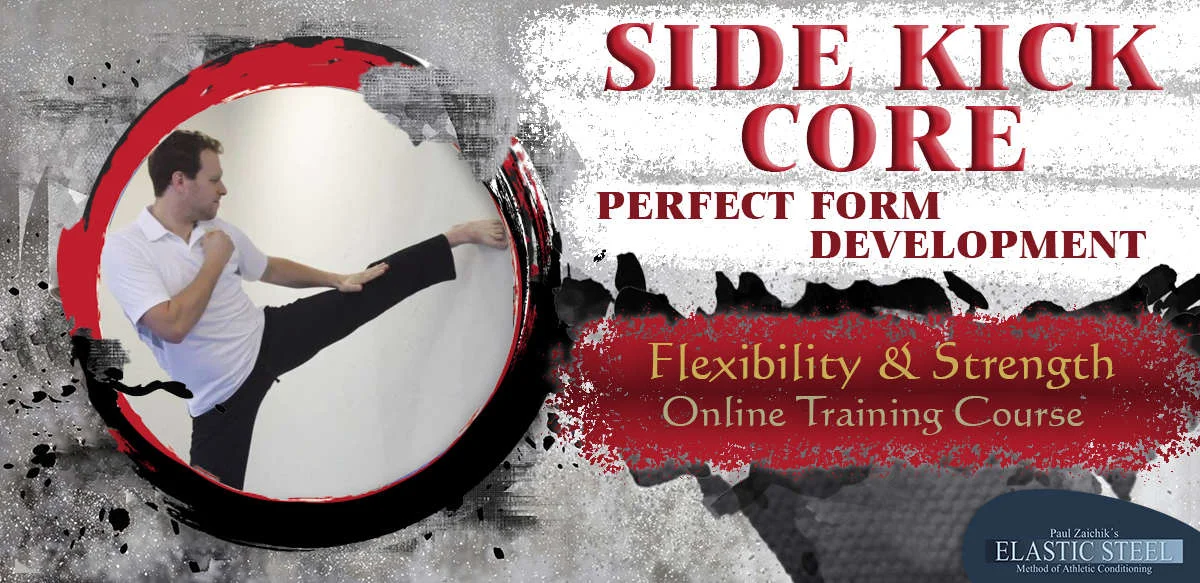
SIDE KICK CORE
PERFECT FORM DEVELOPMENT
PERFECT FORM DEVELOPMENT
Side Kick and Side Line Kicks: Trunk Flexibility and Strength Development for Optimum Kicks Development

SIDE KICK CORE DEVELOPMENTWhat is the difference between a champions and masters Side Kick and beginner Side Kick? (Roundhouse and Hook Kick too for that matter).
Take a second and visualize the two of them kicking side by side. What do you see? One will have his torso up and one will have it down. Torso position is what makes or breaks the 3 sideline kicks.
If your torso is strong and flexible the kick is hard to see when it’s coming. If the trunk is stiff and weak, it will drop before the kick is initiated. It can be seen a mile away.
Thus is takes less effort to throw a kick when the torso does not have to make a trip to the corner store and back every time the leg comes up. Yes, it’s that important and that’s why we made a program for it.
How can I improve my kick?
If your torso is strong and flexible the kick is hard to see when it’s coming. If the trunk is stiff and weak, it will drop before the kick is initiated. It can be seen a mile away.
Thus is takes less effort to throw a kick when the torso does not have to make a trip to the corner store and back every time the leg comes up. Yes, it’s that important and that’s why we made a program for it.
How can I improve my kick?
Over the years many people would ask me to look at their kicks. Even the high kickers. “What can I do to improve my kick?” they asked. “Torso, your torso position”, was a very common response. Most fighters kick and punch. The better positioned the upper body during the kick, the shorter the pause between a kick and a punch. Or punch and a kick for that matter.
Whether you are a pro fighter or you just train for your enjoyment, you know that the faster you can follow up with your hands after the kick, the more chances you will score.
A very flexible torso is what keeps your punches closer to the target, right after the kick.
Finally, there is the look of the kick, of how the form appears. A kick looks much better when the head is not brushing the floor on the high kick. Think of great competitors with awesome techniques.
Ok, enough said. In this program we focus on the flexibility and strength training of the torso. It’s not a six pack program... (however it will greatly develop the core), but body builder looking abs is not its primary purpose. The purpose is to improve every aspect of the Side Kick, Roundhouse Kick and Hook Kick.
Do you need this program?
Whether you are a pro fighter or you just train for your enjoyment, you know that the faster you can follow up with your hands after the kick, the more chances you will score.
A very flexible torso is what keeps your punches closer to the target, right after the kick.
Finally, there is the look of the kick, of how the form appears. A kick looks much better when the head is not brushing the floor on the high kick. Think of great competitors with awesome techniques.
Ok, enough said. In this program we focus on the flexibility and strength training of the torso. It’s not a six pack program... (however it will greatly develop the core), but body builder looking abs is not its primary purpose. The purpose is to improve every aspect of the Side Kick, Roundhouse Kick and Hook Kick.
Do you need this program?
Let’s see. Stand up and extend a Side Kick waist level. With your finger tips touch the outside part of your leg. Perfect kick dictates finger tips touching half way between your knee and your ankle. If you can do that, you don’t need this program. If you can’t touch that, either your strength is off or your flexibility, which means that you need this program.
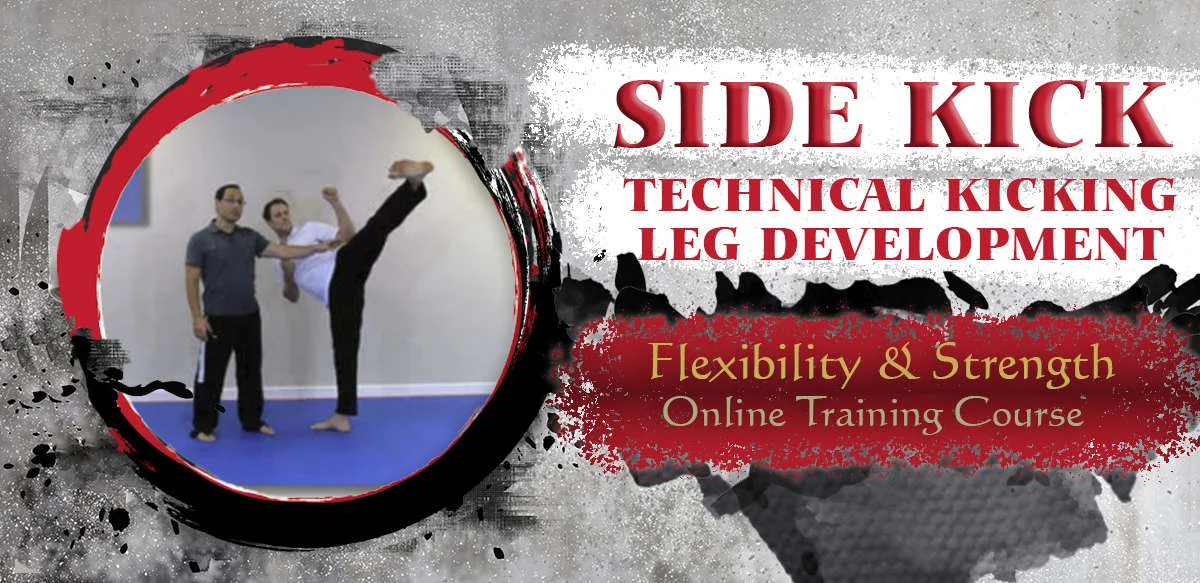
SIDE KICK
Technical Kicking Leg Development
Technical Kicking Leg Development
SIDE KICK: Technical Kicking Leg Development Online Training Program
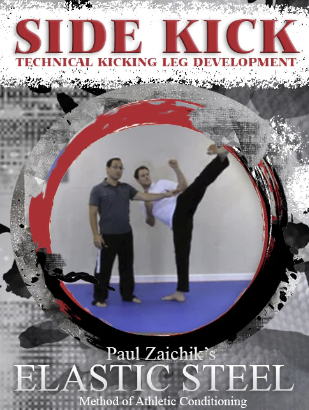
Ideally developing the kicking leg should take place even before a single kick is thrown. However that’s not possible for most people. Everyone who lands on this page, has already thrown kicks.
Ideally developing the kicking leg should take place even before a single kick is thrown. However that’s not possible for most people. Everyone who lands on this page, has already thrown kicks.
How to understand your kicking leg?
To understand the kicking leg, think of a barbell push jerk. That’s when you hold the barbell on your upper chest, in standing position. You use a short leg push to accelerate the bar up and extend the arms over your head.
The little leg jerk is done because the arms are not strong enough to press the weight with assistance. The arms, in this case, is the kicking leg. Would you try to do a push jerk or even a basic shoulder press, if you can’t lift your arms all the way up to vertical position, because you lack shoulder mobility? Of course you would not.
What if your shoulder was not strong enough to even hold your arms there, would you add additional weight? Of course not. And yet people kick without having proper range of motion or strength.
There is no way a proper technique can ever be developed. Never an optimum power, or speed or accuracy. Why? Because your body is more concerned about you not getting injured, than about “mastering” the skill.
The little leg jerk is done because the arms are not strong enough to press the weight with assistance. The arms, in this case, is the kicking leg. Would you try to do a push jerk or even a basic shoulder press, if you can’t lift your arms all the way up to vertical position, because you lack shoulder mobility? Of course you would not.
What if your shoulder was not strong enough to even hold your arms there, would you add additional weight? Of course not. And yet people kick without having proper range of motion or strength.
There is no way a proper technique can ever be developed. Never an optimum power, or speed or accuracy. Why? Because your body is more concerned about you not getting injured, than about “mastering” the skill.
Requirements for a proper Side Kick
A proper side kick performing leg, requires flexibility in the muscles that prevent abduction (lifting the leg to the side) and prevent medial rotation. (Abduction and medial rotation is what your kicking leg is doing, during side line kicks.) While the medial rotators and adductors need to be strong.
But, not just generally strong. They must be strong in short range. (Short range is where muscle is completely flexed) Also strong hip and knee flexors (to have a good chamber). A beginner who starts kicking, can’t possibly have this.
Unless it’s a new generation of beginners, who now train with various certified instructors in ElasticSteel method.
But, not just generally strong. They must be strong in short range. (Short range is where muscle is completely flexed) Also strong hip and knee flexors (to have a good chamber). A beginner who starts kicking, can’t possibly have this.
Unless it’s a new generation of beginners, who now train with various certified instructors in ElasticSteel method.
In this program you will learn:
- How to strengthen the muscles of the kicking leg in proper ranges for optimal kicks.
- Two forms of Zaichik Stretching Technique (formerly known as Kinesiological Stretching Techniques)
- 4 level short range contractions with 3 exercises per level.
Do you need this Program?
I am going to take an educated guess and say that 95 percent of people need it. If you never used this program, you probably need it. I have met and trained with many good kickers and they all needed this program.
Not a single one had all 3 factors that this program works on, fully developed:
I am going to take an educated guess and say that 95 percent of people need it. If you never used this program, you probably need it. I have met and trained with many good kickers and they all needed this program.
Not a single one had all 3 factors that this program works on, fully developed:
- Full active chamber (without hand assistance) and neutral back.
- 35 degrees active medial rotation of the hip.
- Active Extended kick with 45 degree hip abduction and horizontal foot position.
- And the other factor pointing to the necessity of this program, is that every single person who tried it even 2 rounds for the first time (All 4 levels), was sore the next day. If muscles are already used to producing force in these ranges, they would not be sore, after a quick run through the exercises.
I am looking forward to meeting people who can do this program and not be aching the next day. I would be very interested to know how they train. So far haven’t met even one.
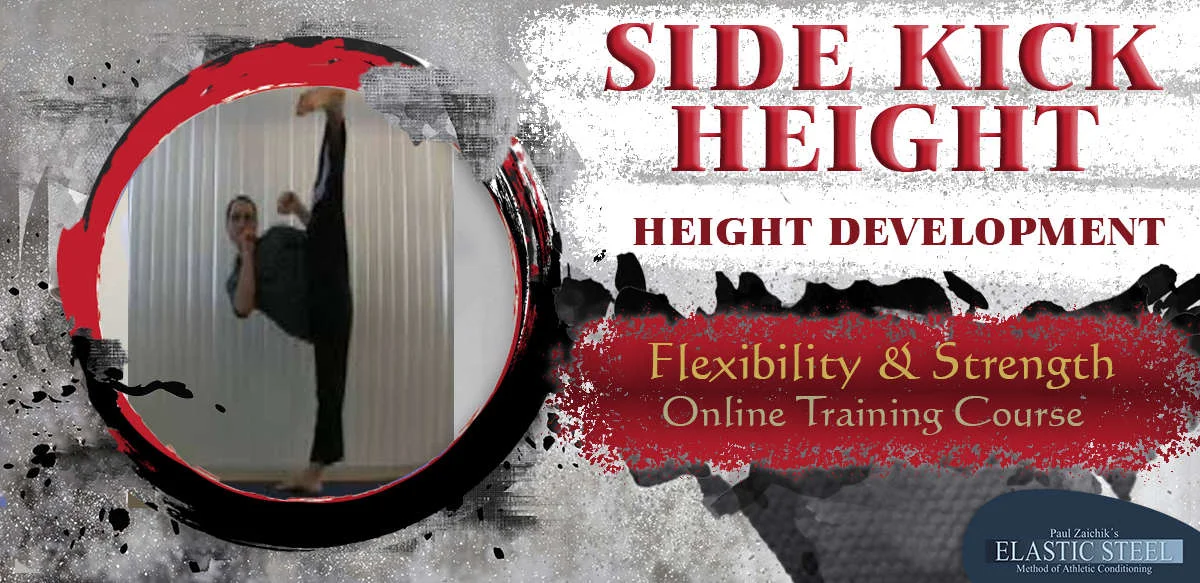
SIDE KICK HEIGHTHEIGHT DEVELOPMENT
Side Kick Height Supporting Leg Online Training Program
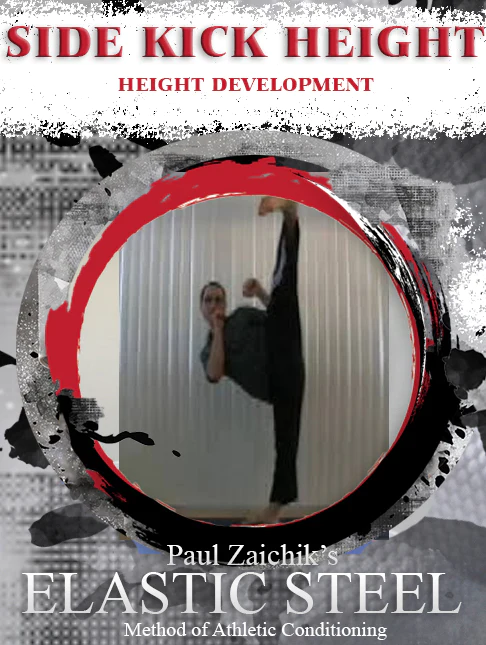
This is a program for the kicking height for all 3 side line kicks:
- Side Kick
- Roundhouse Kick
- Hook Kick
Kicking height of the side line kicks, depends on the flexibility of the supporting leg or standing leg. In order to throw a high kick, the kicking side of the pelvis must tilt up. If the pelvic does not tilt, the kicking hip abduct no more than 45 degrees.
This means that a kick will be thrown no higher than the knee. Even a kick to the groin requires 90 degrees abduction (abduction is lifting of the leg to the side).
This means that a kick will be thrown no higher than the knee. Even a kick to the groin requires 90 degrees abduction (abduction is lifting of the leg to the side).
So the pelvic position must change. Once the pelvis moves, the flexibility of the supporting leg comes into play. Of course not just flexibility, but also strength.
In this training program you will learn:
- Very short and straight to the point method of developing kicking height:
- 3 carefully selected Zaichik Stretching Technique exercises for flexibility (formerly called Kinesiological Stretching Techniques). Each one takes just a few seconds to complete per round. Together these techniques develop super fast flexibility.
- Combined with extended length conditioning strength technique, the body quickly develops the range of motion for high kicks.
Do you need this program? Here's a test:
To test if you need this program:
- Do a side kick.
- Place the foot on the wall.
- Drop your body in the opposite direction. (Away from the wall and away from the kick)
Does your kicking foot travel much higher, if the torso is dropped away? Or does your kicking foot not go any higher, with torso dropped?
If the foot comes up high, you don’t need this program. You need this one (click here for more information).
Plus when you sign up for this course you will also get these bonuses:
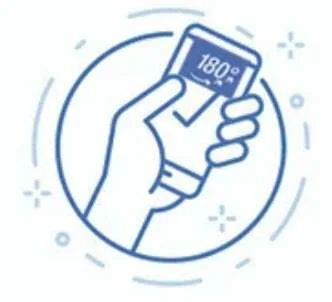
Stretch180 App
Kick Measurement App Online. This app will measure your kicks accurately and tell you how many degrees you are progressing each training session. Track your progress. Keep you engaged and motivated with your training. And keep you focused on your Kicking Goals!

Support Group
Access to a Private Support Group: No longer will you train alone. Now you can be part of a group and train alongside other ElasticSteel practitioners. Once registered for this course you will gain access to a private support group, where you will find 24-hour active community to share your experience with, ask questions and get advice.
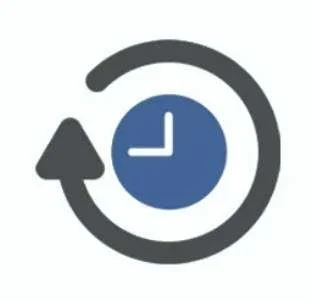
Lifetime Access
Once purchased, this course is your to keep forever! There are no hidden fees and no strings attached. You will not be billed monthly, you pay only one time and get unlimited lifetime access to this program which is kept for you in your very own online library for easy access on any device of your choice, anytime, anywhere.


